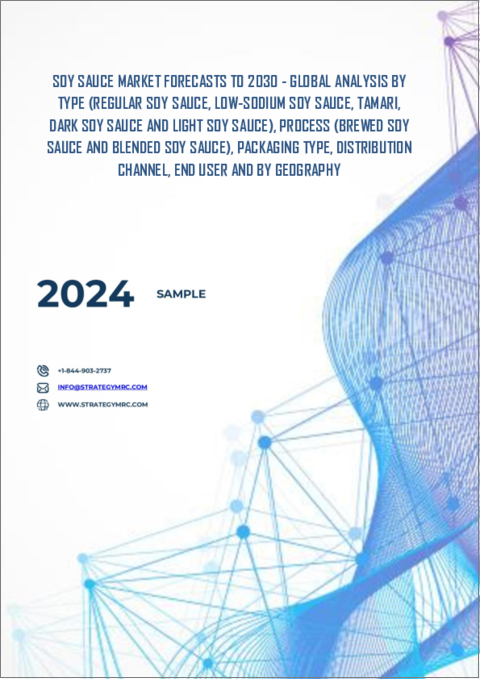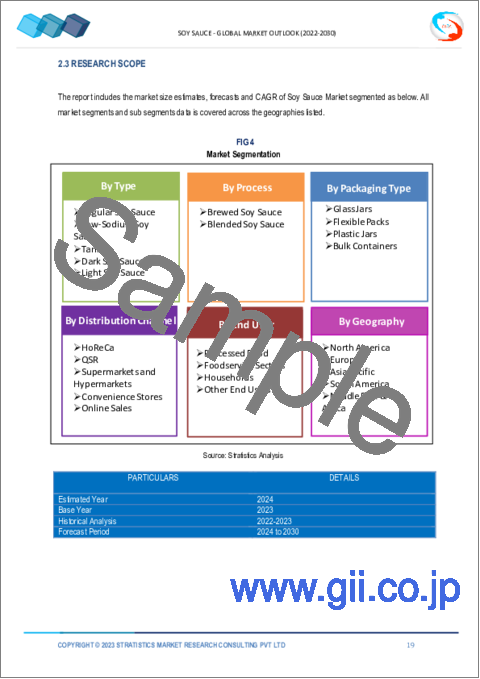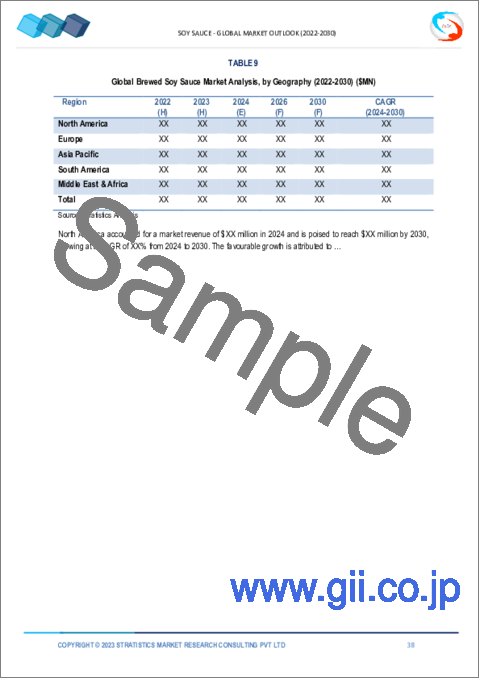|
|
市場調査レポート
商品コード
1577160
醤油市場の2030年までの予測:タイプ別、製法別、包装タイプ別、流通チャネル別、エンドユーザー別、地域別の世界分析Soy Sauce Market Forecasts to 2030 - Global Analysis By Type, Process, Packaging Type, Distribution Channel, End User and by Geography |
||||||
カスタマイズ可能
|
|||||||
| 醤油市場の2030年までの予測:タイプ別、製法別、包装タイプ別、流通チャネル別、エンドユーザー別、地域別の世界分析 |
|
出版日: 2024年10月10日
発行: Stratistics Market Research Consulting
ページ情報: 英文 200+ Pages
納期: 2~3営業日
|
全表示
- 概要
- 図表
- 目次
Stratistics MRCによると、世界の醤油市場は2024年に626億5,000万米ドルを占め、2030年にはCAGAR7.9%で成長し、988億7,000万米ドルに達すると予測されています。
一般的な調味料である醤油は、大豆、小麦、塩、水を発酵させて作られます。東アジアが原産地で、中国、日本、韓国などでは何世紀にもわたり、料理や食品保存の主食として使われてきました。しょうゆの独特のうま味は、数ヶ月を要する発酵工程によって生み出されます。醤油は炒め物、マリネ、ドレッシング、寿司や餃子のつけダレとしてよく使われます。
FAO(国連食糧農業機関)によると、世界の大豆生産量は2022年に3億7,000万トンを超え、その大部分は醤油、豆腐、豆乳などの大豆ベースの製品に使用されており、食品産業における大豆の需要の広がりを裏付けています。
風味付けと調味料のニーズの高まり
世界の消費者は、より風味豊かで多様な味覚体験を求め、世界の食文化の変化をもたらしています。醤油にはうま味があるため、さまざまな食品の風味を高める調味料として使用することができます。シェフもアマチュアの料理人も、マリネやドレッシング、デザートに至るまで醤油を試しており、その用途が伝統的なアジア料理だけにとどまらないことを証明しています。さらに、その多用途性からさまざまな料理への需要が高まり、家庭の厨房でも業務用食品店でも主力商品となっています。
ナトリウム含有による健康問題
醤油のナトリウム含有量の高さがもたらす健康リスクは、醤油市場を阻む最大の障壁のひとつです。伝統的な醤油には高濃度のナトリウムが頻繁に含まれているため、高血圧や心血管疾患のような健康状態を悪化させる可能性があります。消費者の健康意識が高まるにつれ、減塩の代用品への需要が高まっています。さらに、この変化によって従来の醤油製品の市場が縮小する可能性があり、生産者は、現在の生産能力やブランド意識に必ずしも合わないかもしれない、より健康的な代替品を作るための投資を余儀なくされます。
オンライン小売サイトの成長
eコマースの出現は、消費者が醤油などの食品を購入する方法に革命をもたらしました。顧客は、オンライン・プラットフォームを通じて、近隣の店舗では見つけられないような、より幅広いブランドや味にアクセスすることができます。インターネット・マーケティングに注力することで、醤油会社はこの変化を利用して消費者ベースを拡大し、新しい市場や層にアプローチすることができます。さらに、企業はインフルエンサーとの関係やソーシャルメディアを利用して商品を販売し、さまざまな種類の醤油について顧客に知らせ、オンライン販売を刺激することができます。
代替品の脅威
代替調味料の人気が高まっており、醤油市場に深刻な脅威をもたらしています。料理や調理で代用品として使われる製品には、照り焼きソース、たまり、さまざまなホットソースなどがあります。これらの代用品は、グルテンフリーのような特定の食事要件を満たしたり、より幅広い消費者にアピールする独特の風味を持つことが多いです。さらに、こうした代用品が手に入ることで、消費者がより幅広い料理の選択肢を試すようになり、従来の醤油ブランドが市場シェアを失う可能性もあります。
COVID-19の影響:
COVID-19の大流行はさまざまな分野に混乱をもたらし、醤油市場にも大きな影響を与えました。醤油の大口ユーザーであるレストランや飲食店では、ロックダウンや外食制限の結果、外食事業が激減しました。小売店の売上は、買い物客が常備菜を買いだめしたため、一時的に増加したが、サプライチェーンの混乱や貿易規制が原料の入手や流通に影響を及ぼし、市場全体にも問題が生じた。
予測期間中、薄口しょうゆ部門が最大となる見込み
汎用性の高い調味料として人気が高く、さまざまな料理用途に幅広く使用されていることから、淡口醤油分野は醤油業界で最大の市場シェアを占めています。薄口醤油は、濃口醤油よりも粘度が薄く、塩味が強いため、料理に風味を加えたい場合に好まれます。家庭料理でも外食産業でも主力商品であり、マリネや炒め物、つけダレとしてよく使われます。さらに、うま味のある食品を好む傾向の高まりや、世界のアジア料理の人気の高まりも、薄口醤油の需要を支えています。
醸造醤油分野は予測期間中に最も高いCAGRが見込まれる
醤油市場では、醸造醤油分野が最も高いCAGRで成長すると予想されます。この成長の主な理由は、消費者が天然醸造製品の品質と栄養面での優位性をより意識するようになったことです。醸造醤油は伝統的な発酵工程で作られるため、より複雑な風味を持ち、健康志向の消費者と食通の両方から支持されています。さらに、本物の高品質食品に対する消費者の需要が高まるにつれて、家庭用と外食用の両方で醸造醤油の使用が増加しています。
最もシェアの高い地域:
醤油市場に関しては、アジア太平洋地域が最大のシェアを占めています。この地域は、中華料理、日本料理、韓国料理、タイ料理など、さまざまな料理の重要な構成要素として醤油を使用しており、料理の伝統が深く根付いていることがその主な原因です。醤油はこれらの国の文化にとって非常に重要であるため、従来の醤油と独創的な醤油の両方に対する需要が絶えないです。さらに、アジア太平洋地域は、本格的な味への需要の高まりとアジア料理店の世界の拡大により、アジア料理が世界的に人気を集めるにつれて、トップの座を維持すると予測されます。
CAGRが最も高い地域:
しょうゆ市場は欧州地域で大きく成長し、予測期間中のCAGRが最も高くなると予想されます。欧州の消費者がアジアの風味を好むようになり、各国料理への関心が高まっていることが、この成長の主な要因です。料理の多様性が増すにつれて、醤油は万能調味料としてますます好まれるようになっています。伝統的なアジア料理のレシピ以外にも、幅広い料理に使われるようになった。さらに、特にドイツ、フランス、英国では、職人技やグルメ志向の人気が高まっていることも、高級醤油製品の需要を押し上げています。
無料のカスタマイズサービス
本レポートをご購読のお客様には、以下の無料カスタマイズオプションのいずれかをご利用いただけます:
- 企業プロファイル
- 追加市場プレーヤーの包括的プロファイリング(3社まで)
- 主要企業のSWOT分析(3社まで)
- 地域セグメンテーション
- 顧客の関心に応じた主要国の市場推計・予測・CAGR(注:フィージビリティチェックによる)
- 競合ベンチマーキング
- 製品ポートフォリオ、地理的プレゼンス、戦略的提携に基づく主要企業のベンチマーキング
目次
第1章 エグゼクティブサマリー
第2章 序文
- 概要
- ステークホルダー
- 調査範囲
- 調査手法
- データマイニング
- データ分析
- データ検証
- 調査アプローチ
- 調査情報源
- 1次調査情報源
- 2次調査情報源
- 前提条件
第3章 市場動向分析
- 促進要因
- 抑制要因
- 機会
- 脅威
- エンドユーザー分析
- 新興市場
- COVID-19の影響
第4章 ポーターのファイブフォース分析
- 供給企業の交渉力
- 買い手の交渉力
- 代替品の脅威
- 新規参入業者の脅威
- 競争企業間の敵対関係
第5章 世界の醤油市場:タイプ別
- 普通の醤油
- 減塩醤油
- タマリ
- 濃い醤油
- 薄口醤油
第6章 世界の醤油市場:製造工程別
- 醸造醤油
- ブレンド醤油
第7章 世界の醤油市場:包装タイプ別
- ガラス瓶
- フレキシブルパック
- プラスチック瓶
- バルクコンテナ
第8章 世界の醤油市場:流通チャネル別
- ホレカ
- クイックサービス
- スーパーマーケットとハイパーマーケット
- コンビニエンスストア
- オンライン販売
第9章 世界の醤油市場:エンドユーザー別
- 加工食品
- 食品サービス部門
- 世帯
- その他のエンドユーザー
第10章 世界の醤油市場:地域別
- 北米
- 米国
- カナダ
- メキシコ
- 欧州
- ドイツ
- 英国
- イタリア
- フランス
- スペイン
- その他欧州
- アジア太平洋
- 日本
- 中国
- インド
- オーストラリア
- ニュージーランド
- 韓国
- その他アジア太平洋
- 南米
- アルゼンチン
- ブラジル
- チリ
- その他南米
- 中東・アフリカ
- サウジアラビア
- アラブ首長国連邦
- カタール
- 南アフリカ
- その他中東とアフリカ
第11章 主な発展
- 契約、パートナーシップ、コラボレーション、合弁事業
- 買収と合併
- 新製品発売
- 事業拡大
- その他の主要戦略
第12章 企業プロファイリング
- Yamasa Corp.
- Foshan Haitian Flavouring & Food Co. Ltd
- Kikkoman Corporation
- Nestle S.A.
- Bourbon Barrel Foods
- Monggo Foods Co., Ltd.
- Lee Kum Kee
- Kraft Heinz Company
- McCormick & Co Inc.
- Campbell Soup Company
- Haitian
- Eden Foods
- Masan Group
- Otafuku Sauce Co., Ltd.
- Hormel Foods Corporation
List of Tables
- Table 1 Global Soy Sauce Market Outlook, By Region (2022-2030) ($MN)
- Table 2 Global Soy Sauce Market Outlook, By Type (2022-2030) ($MN)
- Table 3 Global Soy Sauce Market Outlook, By Regular Soy Sauce (2022-2030) ($MN)
- Table 4 Global Soy Sauce Market Outlook, By Low-Sodium Soy Sauce (2022-2030) ($MN)
- Table 5 Global Soy Sauce Market Outlook, By Tamari (2022-2030) ($MN)
- Table 6 Global Soy Sauce Market Outlook, By Dark Soy Sauce (2022-2030) ($MN)
- Table 7 Global Soy Sauce Market Outlook, By Light Soy Sauce (2022-2030) ($MN)
- Table 8 Global Soy Sauce Market Outlook, By Process (2022-2030) ($MN)
- Table 9 Global Soy Sauce Market Outlook, By Brewed Soy Sauce (2022-2030) ($MN)
- Table 10 Global Soy Sauce Market Outlook, By Blended Soy Sauce (2022-2030) ($MN)
- Table 11 Global Soy Sauce Market Outlook, By Packaging Type (2022-2030) ($MN)
- Table 12 Global Soy Sauce Market Outlook, By Glass Jars (2022-2030) ($MN)
- Table 13 Global Soy Sauce Market Outlook, By Flexible Packs (2022-2030) ($MN)
- Table 14 Global Soy Sauce Market Outlook, By Plastic Jars (2022-2030) ($MN)
- Table 15 Global Soy Sauce Market Outlook, By Bulk Containers (2022-2030) ($MN)
- Table 16 Global Soy Sauce Market Outlook, By Distribution Channel (2022-2030) ($MN)
- Table 17 Global Soy Sauce Market Outlook, By HoReCa (2022-2030) ($MN)
- Table 18 Global Soy Sauce Market Outlook, By QSR (2022-2030) ($MN)
- Table 19 Global Soy Sauce Market Outlook, By Supermarkets and Hypermarkets (2022-2030) ($MN)
- Table 20 Global Soy Sauce Market Outlook, By Convenience Stores (2022-2030) ($MN)
- Table 21 Global Soy Sauce Market Outlook, By Online Sales (2022-2030) ($MN)
- Table 22 Global Soy Sauce Market Outlook, By End User (2022-2030) ($MN)
- Table 23 Global Soy Sauce Market Outlook, By Processed Food (2022-2030) ($MN)
- Table 24 Global Soy Sauce Market Outlook, By Foodservice Sectors (2022-2030) ($MN)
- Table 25 Global Soy Sauce Market Outlook, By Households (2022-2030) ($MN)
- Table 26 Global Soy Sauce Market Outlook, By Other End Users (2022-2030) ($MN)
Note: Tables for North America, Europe, APAC, South America, and Middle East & Africa Regions are also represented in the same manner as above.
According to Stratistics MRC, the Global Soy Sauce Market is accounted for $62.65 billion in 2024 and is expected to reach $98.87 billion by 2030 growing at a CAGR of 7.9% during the forecast period. A common condiment, soy sauce is created by fermenting soybeans, wheat, salt, and water. Originating in East Asia, it has been a staple ingredient in cooking and food preservation for centuries in nations like China, Japan, and Korea. Soy sauce gets its unique umami flavour-a savoury taste that amplifies the richness of a variety of dishes-from the fermentation process, which can take several months. Soy sauce can be found frequently in stir-fries, marinades, dressings, and as a dipping sauce for sushi and dumplings.
According to the Food and Agriculture Organization (FAO), global soy production reached over 370 million metric tons in 2022, with a significant portion used in soy-based products like soy sauce, tofu, and soy milk, underscoring the widespread demand for soybeans in food industries.
Market Dynamics:
Driver:
Growing need for flavouring and seasoning ingredients
Global consumers are demanding more flavorful and varied palate experiences, which are changing the culinary landscape globally. Since soy sauce has an umami flavor, it can be used as a seasoning to enhance the flavor of a variety of foods. Chefs and amateur cooks alike are experimenting with soy sauce in marinades, dressings, and even desserts, proving that its applications are not just restricted to traditional Asian cuisine. Moreover, the increased demand for it in different culinary applications due to its versatility has made it a mainstay in both home kitchens and commercial food establishments.
Restraint:
Health issues with sodium content
The health risks of soy sauce's high sodium content are one of the biggest barriers to its market. Because traditional soy sauce frequently contains high levels of sodium, it may exacerbate health conditions like hypertension and cardiovascular diseases. The demand for low-sodium substitutes is rising as consumers become more health conscious. Additionally, the market for conventional soy sauce products may become smaller as a result of this change, forcing producers to make investments in creating healthier alternatives that might not always fit with their current capacity for production or sense of brand.
Opportunity:
Growth of online retail sites
The emergence of e-commerce has revolutionized the way consumers purchase food items, such as soy sauce. Customers can access a greater range of brands and flavors through online platforms that they might not find in nearby stores. With focused internet marketing tactics, soy sauce companies can take advantage of this change to expand their consumer base and reach new markets and demographics. Furthermore, businesses can use influencer relationships and social media to market their goods, inform customers about the various varieties of soy sauce, and stimulate online sales.
Threat:
Threats from substitute conditions
A number of increasingly popular alternative condiments pose a serious threat to the soy sauce market. Products used as stand-ins in cooking and food preparation include teriyaki sauce, tamari, and different hot sauces. These substitutes frequently meet particular dietary requirements (like being gluten-free) or have distinctive flavor profiles that appeal to a wider range of consumers. Moreover, the availability of these alternatives may cause traditional soy sauce brands to lose market share as consumers experiment with a wider range of culinary options.
Covid-19 Impact:
The COVID-19 pandemic caused disruptions in multiple sectors, which in turn had a significant impact on the soy sauce market. Restaurants and eateries, which are big users of soy sauce, saw a sharp decline in foodservice operations as a result of lockdowns and restrictions on eating out. Retail sales saw a brief uptick as shoppers stocked up on pantry staples, but supply chain disruptions and trade restrictions that impacted ingredient availability and distribution also caused problems for the market as a whole.
The Light Soy Sauce segment is expected to be the largest during the forecast period
Due to its popularity as a versatile seasoning and its extensive use in a variety of culinary applications, the light soy sauce segment has the largest market share in the soy sauce industry. When it comes to adding flavor to food without overpowering it, light soy sauce is preferred over dark soy sauce because of its thinner consistency and saltier flavor. It's a mainstay in both home cooking and foodservice environments, frequently used in marinades, stir-fries, and as a dipping sauce. Additionally, the demand for light soy sauce is further supported by the growing trend toward umami-rich foods and the rising appeal of Asian cuisines worldwide.
The Brewed Soy Sauce segment is expected to have the highest CAGR during the forecast period
In the soy sauce market, the brewed soy sauce segment is anticipated to grow at the highest CAGR. The main reason for this growth is that consumers are becoming more conscious of the quality and nutritional advantages of naturally brewed products. Because it is made using a traditional fermentation process, brewed soy sauce has a more complex flavour and is therefore favored by both health-conscious consumers and foodies. Furthermore, the use of brewed soy sauce in both home and foodservice applications is growing as consumer demand for genuine, high-quality food products rises.
Region with largest share:
With regard to the soy sauce market, the Asia Pacific region has the largest share. The primary cause of this dominance is the region's deeply ingrained culinary traditions, which use soy sauce as a key component of many different cuisines, such as Chinese, Japanese, Korean, and Thai. Because soy sauce is so important to these nations' cultures, there is a constant demand for both conventional and creative soy sauce varieties. Moreover, the Asia Pacific region is predicted to hold its top spot as Asian cuisines become more and more popular worldwide, helped along by a growing demand for real flavors and the expansion of Asian eateries across the globe.
Region with highest CAGR:
The soy sauce market is expected to grow significantly in the Europe region, with the highest projected CAGR over the forecast period. European consumers growing appreciation for Asian flavors and their growing interest in international cuisines are the main drivers of this growth. Soy sauce has become more and more well-liked as a versatile condiment as culinary diversity increases. It can now be found in a wide range of dishes outside of traditional Asian recipes. Furthermore, the growing popularity of artisanal and gourmet food trends, especially in Germany, France, and the UK, is also driving up demand for premium soy sauce products.
Key players in the market
Some of the key players in Soy Sauce market include Yamasa Corp., Foshan Haitian Flavouring & Food Co. Ltd, Kikkoman Corporation, Nestle S.A., Bourbon Barrel Foods, Monggo Foods Co., Ltd., Lee Kum Kee, Kraft Heinz Company, McCormick & Co Inc., Campbell Soup Company, Haitian, Eden Foods, Masan Group, Otafuku Sauce Co., Ltd. and Hormel Foods Corporation
Key Developments:
In May 2024, Kraft Heinz Canada and Highbury Canco announced the extension of their partnership agreement in Leamington for another four years, with the production deal now in place until the end of 2027. Today's announcement marks the third consecutive extension in the longstanding partnership between the two organizations in Southern Ontario, a connection that has served to support jobs and bolster the local economy.
In February 2024, Nestle, in a move to streamline its operations, has entered into a slump sale agreement for its Nestle Business Services (NBS) Division with Purina PetCare India, a wholly-owned subsidiary of Nestle S.A. The deal, valued at ₹798 million, is set to be effective from July 1, 2024, subject to customary closing conditions.
In August 2023, Campbell Soup Company and Sovos Brands, Inc. announced that the companies have entered into an agreement for Campbell to acquire Sovos Brands, Inc. for $23 per share in cash, representing a total enterprise value of approximately $2.7 billion.
Types Covered:
- Regular Soy Sauce
- Low-Sodium Soy Sauce
- Tamari
- Dark Soy Sauce
- Light Soy Sauce
Processes Covered:
- Brewed Soy Sauce
- Blended Soy Sauce
Packaging Types Covered:
- Glass Jars
- Flexible Packs
- Plastic Jars
- Bulk Containers
Distribution Channels Covered:
- HoReCa
- QSR
- Supermarkets and Hypermarkets
- Convenience Stores
- Online Sales
End Users Covered:
- Processed Food
- Foodservice Sectors
- Households
- Other End Users
Regions Covered:
- North America
- US
- Canada
- Mexico
- Europe
- Germany
- UK
- Italy
- France
- Spain
- Rest of Europe
- Asia Pacific
- Japan
- China
- India
- Australia
- New Zealand
- South Korea
- Rest of Asia Pacific
- South America
- Argentina
- Brazil
- Chile
- Rest of South America
- Middle East & Africa
- Saudi Arabia
- UAE
- Qatar
- South Africa
- Rest of Middle East & Africa
What our report offers:
- Market share assessments for the regional and country-level segments
- Strategic recommendations for the new entrants
- Covers Market data for the years 2022, 2023, 2024, 2026, and 2030
- Market Trends (Drivers, Constraints, Opportunities, Threats, Challenges, Investment Opportunities, and recommendations)
- Strategic recommendations in key business segments based on the market estimations
- Competitive landscaping mapping the key common trends
- Company profiling with detailed strategies, financials, and recent developments
- Supply chain trends mapping the latest technological advancements
Free Customization Offerings:
All the customers of this report will be entitled to receive one of the following free customization options:
- Company Profiling
- Comprehensive profiling of additional market players (up to 3)
- SWOT Analysis of key players (up to 3)
- Regional Segmentation
- Market estimations, Forecasts and CAGR of any prominent country as per the client's interest (Note: Depends on feasibility check)
- Competitive Benchmarking
- Benchmarking of key players based on product portfolio, geographical presence, and strategic alliances
Table of Contents
1 Executive Summary
2 Preface
- 2.1 Abstract
- 2.2 Stake Holders
- 2.3 Research Scope
- 2.4 Research Methodology
- 2.4.1 Data Mining
- 2.4.2 Data Analysis
- 2.4.3 Data Validation
- 2.4.4 Research Approach
- 2.5 Research Sources
- 2.5.1 Primary Research Sources
- 2.5.2 Secondary Research Sources
- 2.5.3 Assumptions
3 Market Trend Analysis
- 3.1 Introduction
- 3.2 Drivers
- 3.3 Restraints
- 3.4 Opportunities
- 3.5 Threats
- 3.6 End User Analysis
- 3.7 Emerging Markets
- 3.8 Impact of Covid-19
4 Porters Five Force Analysis
- 4.1 Bargaining power of suppliers
- 4.2 Bargaining power of buyers
- 4.3 Threat of substitutes
- 4.4 Threat of new entrants
- 4.5 Competitive rivalry
5 Global Soy Sauce Market, By Type
- 5.1 Introduction
- 5.2 Regular Soy Sauce
- 5.3 Low-Sodium Soy Sauce
- 5.4 Tamari
- 5.5 Dark Soy Sauce
- 5.6 Light Soy Sauce
6 Global Soy Sauce Market, By Process
- 6.1 Introduction
- 6.2 Brewed Soy Sauce
- 6.3 Blended Soy Sauce
7 Global Soy Sauce Market, By Packaging Type
- 7.1 Introduction
- 7.2 Glass Jars
- 7.3 Flexible Packs
- 7.4 Plastic Jars
- 7.5 Bulk Containers
8 Global Soy Sauce Market, By Distribution Channel
- 8.1 Introduction
- 8.2 HoReCa
- 8.3 QSR
- 8.4 Supermarkets and Hypermarkets
- 8.5 Convenience Stores
- 8.6 Online Sales
9 Global Soy Sauce Market, By End User
- 9.1 Introduction
- 9.2 Processed Food
- 9.3 Foodservice Sectors
- 9.4 Households
- 9.5 Other End Users
10 Global Soy Sauce Market, By Geography
- 10.1 Introduction
- 10.2 North America
- 10.2.1 US
- 10.2.2 Canada
- 10.2.3 Mexico
- 10.3 Europe
- 10.3.1 Germany
- 10.3.2 UK
- 10.3.3 Italy
- 10.3.4 France
- 10.3.5 Spain
- 10.3.6 Rest of Europe
- 10.4 Asia Pacific
- 10.4.1 Japan
- 10.4.2 China
- 10.4.3 India
- 10.4.4 Australia
- 10.4.5 New Zealand
- 10.4.6 South Korea
- 10.4.7 Rest of Asia Pacific
- 10.5 South America
- 10.5.1 Argentina
- 10.5.2 Brazil
- 10.5.3 Chile
- 10.5.4 Rest of South America
- 10.6 Middle East & Africa
- 10.6.1 Saudi Arabia
- 10.6.2 UAE
- 10.6.3 Qatar
- 10.6.4 South Africa
- 10.6.5 Rest of Middle East & Africa
11 Key Developments
- 11.1 Agreements, Partnerships, Collaborations and Joint Ventures
- 11.2 Acquisitions & Mergers
- 11.3 New Product Launch
- 11.4 Expansions
- 11.5 Other Key Strategies
12 Company Profiling
- 12.1 Yamasa Corp.
- 12.2 Foshan Haitian Flavouring & Food Co. Ltd
- 12.3 Kikkoman Corporation
- 12.4 Nestle S.A.
- 12.5 Bourbon Barrel Foods
- 12.6 Monggo Foods Co., Ltd.
- 12.7 Lee Kum Kee
- 12.8 Kraft Heinz Company
- 12.9 McCormick & Co Inc.
- 12.10 Campbell Soup Company
- 12.11 Haitian
- 12.12 Eden Foods
- 12.13 Masan Group
- 12.14 Otafuku Sauce Co., Ltd.
- 12.15 Hormel Foods Corporation






